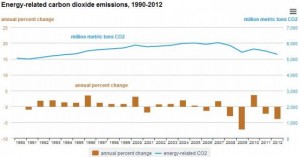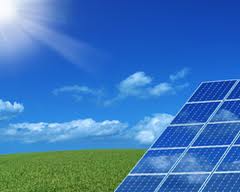Americans are Using Less Energy: Is Change Around the Corner?
Oct 22nd, 2013 | By admin | Category: Energy and Carbon EmissionsBy Suzanne York, www.howmany.org
The U.S. Energy Information Administration just released a report showing that the carbon dioxide pollution emitted by Americans dropped 3.8 percent in 2012.
Though U.S. CO2 emissions in 2012 amounted to 368,000 pounds of pollution per second, this is the lowest level since 1994.
Ryan Koronowski of Climate Progress wrote that “The drop in 2009 was largely due to the contraction in the U.S. economy during the Great Recession, yet the falling carbon dioxide emissions in 2012 occurred while GDP rose 2.8 percent. Energy consumption fell by 2.8 percent.”
He stated that the main reason for this is that “American energy intensity dropped — energy use per dollar of GDP fell 6.5 percent. The economy was able to do more with less energy, which has been a long-term trend ever since an inefficient high in 1970.”
According to climate scientist Michael Mann, with, Pennsylvania State University, the drop “is reason for cautious optimism that we’re already starting to move in the right direction, but this alone will not lead us toward the dramatic carbon reductions necessary to avoid dangerous climate change.”
Changing the System
This news came out as the National Bioneers Conference was ending in California. Bioneers is an annual gathering that focuses on” the original whole-systems forum of innovation and collaboration for social, cultural and environmental resilience.” Energy and climate change came up quite a bit over the weekend.
One of this year’s speakers was Billy Parish, founder of Mosaic, an organization with a mission “to open up clean energy investing and fundamentally change the way energy is financed” by funding smaller projects the big banks won’t. He is interested in creating transformational change and moving the country out of dirty fossil fuel energy.Parish noted in his presentation that the average American thinks about where their energy comes from 6 minutes a year. He said what is unfortunately true and obvious – that “we lack the political and societal will to transform to 100% clean energy” even though it can be done. His business model is based on small, individual investments in renewable energy systems (read more here by Parish on the fastest way to get to 100% clean energy).
Ramping Up Renewables
Germany was held up as a model to replicate. Solar is becoming king in a country that gets the same amount of sunlight as Alaska. As of 2012, Germany had installed about 30 gigawatts of solar capacity, providing between 3 percent and 10 percent of its electricity. The United States, by contrast, has somewhere around 6.4 gigawatts of solar capacity. But with the price of solar going down, down, down, the time is ripe for investing in solar and other renewables.
And in Germany, 40% of its renewable energy is owned by individuals, which is forcing utilities to rethink old business models.
“Change is Inevitable”
Rethinking many of our business-as-usual models is going to be needed, the sooner the better. Annie Leonard of the Story of Stuff fame told the crowd at her sustainability panel words of wisdom for all of us today – “change is not only possible, it is inevitable.” When more people realize and accept this, then we can find the societal and political will to do it.


